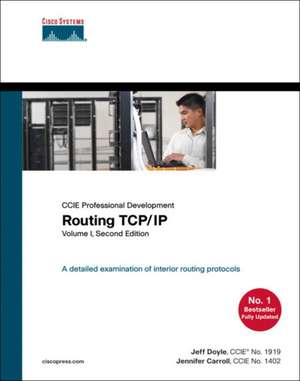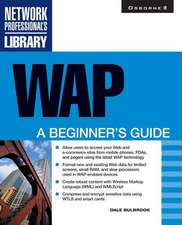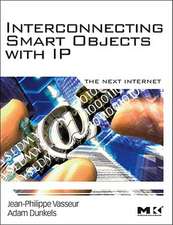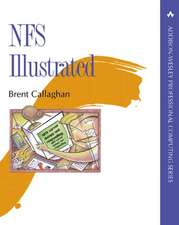CCIE Professional Development Routing TCP/IP: Volume 1: CCIE Professional Development Routing TCP/IP, cartea 01
Autor Jennifer Carroll, Jeff Doyleen Limba Engleză Hardback – 30 sep 2005
Preț: 446.84 lei
Preț vechi: 558.55 lei
-20% Nou
Puncte Express: 670
Preț estimativ în valută:
85.50€ • 89.27$ • 70.76£
85.50€ • 89.27$ • 70.76£
Carte disponibilă
Livrare economică 14-28 martie
Livrare express 28 februarie-06 martie pentru 75.16 lei
Preluare comenzi: 021 569.72.76
Specificații
ISBN-13: 9781587052026
ISBN-10: 1587052024
Pagini: 911
Dimensiuni: 188 x 240 x 53 mm
Greutate: 1.63 kg
Ediția:Nouă
Editura: Cisco Press
Seria CCIE Professional Development Routing TCP/IP
Locul publicării:Indianapolis, United States
ISBN-10: 1587052024
Pagini: 911
Dimensiuni: 188 x 240 x 53 mm
Greutate: 1.63 kg
Ediția:Nouă
Editura: Cisco Press
Seria CCIE Professional Development Routing TCP/IP
Locul publicării:Indianapolis, United States
Descriere
A detailed examination of interior routing protocols -- completely updated in a new edition
Praised in its first edition for its approachable style and wealth of information, this new edition provides readers a deep understanding of IP routing protocols, teaches how to implement these protocols using Cisco routers, and brings readers up to date protocol and implementation enhancements. Routing TCP/IP, Volume 1, Second Edition, includes protocol changes and Cisco features that enhance routing integrity, secure routers from attacks initiated through routing protocols, and provide greater control over the propagation of routing information for all the IP interior routing protocols. Routing TCP/IP, Volume 1, Second Edition, provides a detailed analysis of each of the IP interior gateway protocols (IGPs). Its structure remains the same as the best-selling first edition, though information within each section is enhanced and modified to include the new developments in routing protocols and Cisco implementations. What's New In This Edition? The first edition covers routing protocols as they existed in 1998. The new book updates all covered routing protocols and discusses new features integrated in the latest version of Cisco IOS Software. IPv6, its use with interior routing protocols, and its interoperability and integration with IPv4 are also integrated into this book. Approximately 200 pages of new information are added to the main text, with some old text removed. Additional exercise and solutions are also included.
- A complete revision of the best-selling first edition--widely considered a premier text on TCP/IP routing protocols
- A core textbook for CCIE preparation and a practical reference for network designers, administrators, and engineers
- Includes configuration and troubleshooting lessons that would cost thousands to learn in a classroom and numerous real-world examples and case studies
Praised in its first edition for its approachable style and wealth of information, this new edition provides readers a deep understanding of IP routing protocols, teaches how to implement these protocols using Cisco routers, and brings readers up to date protocol and implementation enhancements. Routing TCP/IP, Volume 1, Second Edition, includes protocol changes and Cisco features that enhance routing integrity, secure routers from attacks initiated through routing protocols, and provide greater control over the propagation of routing information for all the IP interior routing protocols. Routing TCP/IP, Volume 1, Second Edition, provides a detailed analysis of each of the IP interior gateway protocols (IGPs). Its structure remains the same as the best-selling first edition, though information within each section is enhanced and modified to include the new developments in routing protocols and Cisco implementations. What's New In This Edition? The first edition covers routing protocols as they existed in 1998. The new book updates all covered routing protocols and discusses new features integrated in the latest version of Cisco IOS Software. IPv6, its use with interior routing protocols, and its interoperability and integration with IPv4 are also integrated into this book. Approximately 200 pages of new information are added to the main text, with some old text removed. Additional exercise and solutions are also included.
Cuprins
Part I Routing Basics
Chapter 1 TCP/IP Review
TCP/IP Protocol Layers
IP Packet Header
IPv4 Addresses
First Octet Rule
Address Masks
Subnets and Subnet Masks
Designing Subnets
Breaking the Octet Boundary
Troubleshooting a Subnet Mask
Address Resolution Protocol (ARP)
Proxy ARP
Gratuitous ARP
Reverse ARP
Internet Control Message Protocol (ICMP)
Host-to-Host Layer
TCP
UDP
Looking Ahead
Summary Table: Chapter 1 Command Review
Recommended Reading
Review Questions
Configuration Exercises
Troubleshooting Exercises
Chapter 2 IPv6 Overview
IPv6 Addresses
Address Representation
IPv6 Address Types
Global Unicast Addresses
Identifying IPv6 Address Types
Local Unicast Addresses
Anycast Addresses
Multicast Addresses
Embedded IPv4 Addresses
IPv6 Packet Header Format
Extension Headers
ICMPv6
Neighbor Discovery Protocol
NDP Messages
Router Discovery
Address Autoconfiguration
Duplicate Address Detection
Neighbor Address Resolution
Privacy Addresses
Neighbor Unreachability Detection
Looking Ahead
Review Questions
Chapter 3 Static Routing
Route Table
Configuring Static Routes
Case Study: Simple IPv4 Static Routes
Case Study: Simple IPv6 Static Routes
Case Study: Summary Routes
Case Study: Alternative Routes
Case Study: Floating Static Routes
Case Study: IPv6 Floating Static Routes
Case Study: Load Sharing
Load Sharing and Cisco Express Forwarding
Per Destination Load Sharing and Fast Switching
Per Packet Load Sharing and Process Switching
Which Switching Method Will Be Used?
Case Study: Recursive Table Lookups
Troubleshooting Static Routes
Case Study: Tracing a Failed Route
Case Study: A Protocol Conflict
Case Study: A Replaced Router
Case Study: Tracing An IPv6 Failed Route
Looking Ahead
Summary Table: Chapter 3 Command Review
Review Questions
Configuration Exercises
Troubleshooting Exercises
Chapter 4 Dynamic Routing Protocols
Routing Protocol Basics
Path Determination
Metrics
Hop Count
Bandwidth
Load
Delay
Reliability
Cost
Convergence
Load Balancing
Distance Vector Routing Protocols
Common Characteristics
Periodic Updates
Neighbors
Broadcast Updates
Full Routing Table Updates
Routing by Rumor
Route Invalidation Timers
Split Horizon
Counting to Infinity
Triggered Updates
Holddown Timers
Asynchronous Updates
Link State Routing Protocols
Neighbors
Link State Flooding
Sequence Numbers
Aging
Link State Database
SPF Algorithm
Areas
Interior and Exterior Gateway Protocols
Static or Dynamic Routing?
Looking Ahead
Recommended Reading
Review Questions
Part II Interior Routing Protocols
Chapter 5 Routing Information Protocol (RIP)
Operation of RIP
RIP Timers and Stability Features
RIP Message Format
Request Message Types
Classful Routing
Classful Routing: Directly Connected Subnets
Classful Routing: Summarization at Boundary Routers
Classful Routing: Summary
Configuring RIP
Case Study: A Basic RIP Configuration
Case Study: Passive Interfaces
Case Study: Configuring Unicast Updates
Case Study: Discontiguous Subnets
Case Study: Manipulating RIP Metrics
Case Study: Minimizing the Impact of Updates
Troubleshooting RIP
Looking Ahead
Summary Table: Chapter 5 Command Review
Recommended Reading
Review Questions
Configuration Exercises
Troubleshooting Exercises
Chapter 6 RIPv2, RIPng, and Classless Routing
Operation of RIPv2
RIPv2 Message Format
Compatibility with RIPv1
Classless Route Lookups
Classless Routing Protocols
Variable-Length Subnet Masking
Authentication
Operation of RIPng
Configuring RIPv2
Case Study: A Basic RIPv2 Configuration
Case Study: Compatibility with RIPv1
Case Study: Using VLSM
Case Study: Discontiguous Subnets and Classless Routing
Case Study: Authentication
Configuring RIPng
Case Study: Basic RIPng Configuration
Case Study: RIPng Process Customization
Case Study: Metric Manipulation
Case Study: Route Summarization
Troubleshooting RIPv2 and RIPng
Case Study: Misconfigured VLSM
Looking Ahead
Summary Table: Chapter 6 Command Review
Recommended Reading
Review Questions
Configuration Exercises
Troubleshooting Exercises
Chapter 7 Enhanced Interior Gateway Routing Protocol (EIGRP)
The Roots of EIGRP: An Overview of IGRP
Process Domains
IGRP Timers and Stability Features
IGRP Metrics
From IGRP to EIGRP
Operation of EIGRP
Protocol-Dependent Modules
Reliable Transport Protocol
Neighbor Discovery/Recovery
Diffusing Update Algorithm
DUAL: Preliminary Concepts
DUAL Finite State Machine
Diffusing Computation: Example 1
Diffusing Computation: Example 2
EIGRP Packet Formats
EIGRP Packet Header
General TLV Fields
IP-Specific TLV Fields
Address Aggregation
EIGRP and IPv6
Configuring EIGRP
Case Study: A Basic EIGRP Configuration
Case Study: Unequal-Cost Load Balancing
Case Study: Setting Maximum Paths
Case Study: Multiple EIGRP Processes
Case Study: Disabling Automatic Summarization
Case Study: Stub Routing
Case Study: Address Summarization
Authentication
Troubleshooting EIGRP
Case Study: A Missing Neighbor
Stuck-in-Active Neighbors
Looking Ahead
Summary Table: Chapter 7 Command Review
Review Questions
Configuration Exercises
Troubleshooting Exercises
Chapter 8 OSPFv2
Operation of OSPF
Neighbors and Adjacencies
Hello Protocol
Network Types
Designated Routers and Backup Designated Routers
OSPF Interfaces
OSPF Neighbors
Flooding
Areas
Router Types
Partitioned Areas
Virtual Links
Link-State Database
LSA Types
Stub Areas
Route Table
Destination Types
Path Types
Route Table Lookups
Authentication
OSPF over Demand Circuits
OSPF Packet Formats
Packet Header
Hello Packet
Database Description Packet
Link State Request Packet
Link State Update Packet
Link State Acknowledgment Packet
OSPF LSA Formats
LSA Header
Router LSA
Network LSA
Network and ASBR Summary LSAs
Autonomous System External LSA
NSSA External LSA
Options Field
Configuring OSPF
Case Study: A Basic OSPF Configuration
Case Study: Setting Router IDs with Loopback Interfaces
Case Study: Domain Name Service Lookups
Case Study: OSPF and Secondary Addresses
Case Study: Stub Areas
Case Study: Totally Stubby Areas
Case Study: Not-So-Stubby Areas
Case Study: Address Summarization
Case Study: Filtering Between Areas
Case Study: Authentication
Case Study: Virtual Links
Case Study: OSPF on NBMA Networks
Case Study: OSPF over Demand Circuits
Troubleshooting OSPF
Case Study: An Isolated Area
Case Study: Misconfigured Summarization
Looking Ahead
Summary Table: Chapter 8 Command Review
Recommended Reading
Review Questions
Configuration Exercises
Troubleshooting Exercises
Chapter 9 OSPFv3
Operation of OSPFv3
OSPFv3 Differences from OSPFv2
OSPFv3 Messages
An Overview of OSPFv3 LSAs
OSPFv3 LSA Formats
The Router LSA
Network LSA
Inter-Area Prefix LSA
Inter-Area Router LSA
AS-External LSA
Link LSA 489
Intra-Area Prefix LSA
Options Field
Configuring OSPFv3
Case Study: A Basic OSPFv3 Configuration
Case Study: Stub Areas
Case Study: Multiple Instances on a Link
Case Study: OSPFv3 on NBMA Networks
Troubleshooting OSPFv3
Case Study: Frame-Relay Mapping
Looking Ahead 509
Summary Table: Chapter 9 Command Review
Recommended Reading
Review Questions
Configuration Exercises
Chapter 10 Integrated IS-IS
Operation of Integrated IS-IS
IS-IS Areas
Network Entity Titles
IS-IS Functional Organization
Subnetwork Dependent Functions
Subnetwork Independent Functions
IS-IS PDU Formats
TLV Fields
IS-IS Hello PDU Format
IS-IS Link State PDU Format
IS-IS Sequence Numbers PDU Format
Extensions to IS-IS
3-Way Handshaking
Domain-Wide Prefix Distribution
Wide Metrics
Routing IPv6 with IS-IS
Dynamic Hostname Exchange
Multiple Topologies
Mesh Groups
Flooding Delays
Improving SPF Efficiency
Configuring Integrated IS-IS
Case Study: A Basic IPv4 Integrated IS-IS Configuration
Case Study: Changing the Router Types
Case Study: An Area Migration
Case Study: Route Summarization
Case Study: Authentication
Case Study: A Basic Integrated IS-IS Configuration for IPv6
Case Study: Transition to Multiple Topology Mode
Case Study: Route Leaking Between Levels
Case Study: Multiple L1 Areas Active on A Router
Troubleshooting Integrated IS-IS
Troubleshooting IS-IS Adjacencies
Troubleshooting the IS-IS Link-State Database
Case Study: Integrated IS-IS on NBMA Networks
Looking Ahead
Summary Table: Chapter 10 Command Review
Review Questions
Configuration Exercises
Troubleshooting Exercises
Part III Route Control and Interoperability
Chapter 11 Route Redistribution
Principles of Redistribution
Metrics
Administrative Distances
Redistributing from Classless to Classful Protocols
Configuring Redistribution
Case Study: Redistributing IGRP and RIP
Case Study: Redistributing EIGRP and OSPF
Case Study: Redistribution and Route Summarization
Case Study: Redistributing OSPFv3 and RIPng
Case Study: Redistributing IS-IS and RIP/RIPng
Case Study: Redistributing Static Routes
Looking Ahead
Summary Table: Chapter 11 Command Review
Review Questions
Configuration Exercises
Troubleshooting Exercises
Chapter 12 Default Routes and On-Demand Routing
Fundamentals of Default Routes 677
Fundamentals of On-Demand Routing
Configuring Default Routes and ODR
Case Study: Static Default Routes
Case Study: The Default-Network Command
Case Study: The Default-Information Originate Command
Case Study: Configuring On-Demand Routing
Looking Ahead
Summary Table: Chapter 12 Command Review
Review Questions
Chapter 13 Route Filtering
Configuring Route Filters
Case Study: Filtering Specific Routes
Case Study: Route Filtering and Redistribution
Case Study: A Protocol Migration
Case Study: Multiple Redistribution Points
Case Study: Using Administrative Distances to Set Router Preferences
Looking Ahead
Summary Table: Chapter 13 Command Review
Configuration Exercises
Troubleshooting Exercises
Chapter 14 Route Maps
Basic Uses of Route Maps
Configuring Route Maps
Case Study: Policy Routing
Case Study: Policy Routing and Quality of Service Routing
Case Study: Route Maps and Redistribution
Case Study: Route Tagging
Case Study: Filtering Tagged Routes Out of OSPF Route Table
Case Study: IPv6 Redistribution with Route Maps
Looking Ahead
Summary Table: Chapter 14 Command Review
Review Questions
Configuration Exercises
Troubleshooting Exercise
Part IV Appendixes
Appendix A Tutorial : Working with Binary and Hex
Appendix B Tutorial : Access Lists
Appendix C CCIE Preparation Tips
Appendix D Answers to Review Questions
Appendix E Solutions to Configuration Exercises
Appendix F Solutions to Troubleshooting Exercises
1587052024TC092705
Chapter 1 TCP/IP Review
TCP/IP Protocol Layers
IP Packet Header
IPv4 Addresses
First Octet Rule
Address Masks
Subnets and Subnet Masks
Designing Subnets
Breaking the Octet Boundary
Troubleshooting a Subnet Mask
Address Resolution Protocol (ARP)
Proxy ARP
Gratuitous ARP
Reverse ARP
Internet Control Message Protocol (ICMP)
Host-to-Host Layer
TCP
UDP
Looking Ahead
Summary Table: Chapter 1 Command Review
Recommended Reading
Review Questions
Configuration Exercises
Troubleshooting Exercises
Chapter 2 IPv6 Overview
IPv6 Addresses
Address Representation
IPv6 Address Types
Global Unicast Addresses
Identifying IPv6 Address Types
Local Unicast Addresses
Anycast Addresses
Multicast Addresses
Embedded IPv4 Addresses
IPv6 Packet Header Format
Extension Headers
ICMPv6
Neighbor Discovery Protocol
NDP Messages
Router Discovery
Address Autoconfiguration
Duplicate Address Detection
Neighbor Address Resolution
Privacy Addresses
Neighbor Unreachability Detection
Looking Ahead
Review Questions
Chapter 3 Static Routing
Route Table
Configuring Static Routes
Case Study: Simple IPv4 Static Routes
Case Study: Simple IPv6 Static Routes
Case Study: Summary Routes
Case Study: Alternative Routes
Case Study: Floating Static Routes
Case Study: IPv6 Floating Static Routes
Case Study: Load Sharing
Load Sharing and Cisco Express Forwarding
Per Destination Load Sharing and Fast Switching
Per Packet Load Sharing and Process Switching
Which Switching Method Will Be Used?
Case Study: Recursive Table Lookups
Troubleshooting Static Routes
Case Study: Tracing a Failed Route
Case Study: A Protocol Conflict
Case Study: A Replaced Router
Case Study: Tracing An IPv6 Failed Route
Looking Ahead
Summary Table: Chapter 3 Command Review
Review Questions
Configuration Exercises
Troubleshooting Exercises
Chapter 4 Dynamic Routing Protocols
Routing Protocol Basics
Path Determination
Metrics
Hop Count
Bandwidth
Load
Delay
Reliability
Cost
Convergence
Load Balancing
Distance Vector Routing Protocols
Common Characteristics
Periodic Updates
Neighbors
Broadcast Updates
Full Routing Table Updates
Routing by Rumor
Route Invalidation Timers
Split Horizon
Counting to Infinity
Triggered Updates
Holddown Timers
Asynchronous Updates
Link State Routing Protocols
Neighbors
Link State Flooding
Sequence Numbers
Aging
Link State Database
SPF Algorithm
Areas
Interior and Exterior Gateway Protocols
Static or Dynamic Routing?
Looking Ahead
Recommended Reading
Review Questions
Part II Interior Routing Protocols
Chapter 5 Routing Information Protocol (RIP)
Operation of RIP
RIP Timers and Stability Features
RIP Message Format
Request Message Types
Classful Routing
Classful Routing: Directly Connected Subnets
Classful Routing: Summarization at Boundary Routers
Classful Routing: Summary
Configuring RIP
Case Study: A Basic RIP Configuration
Case Study: Passive Interfaces
Case Study: Configuring Unicast Updates
Case Study: Discontiguous Subnets
Case Study: Manipulating RIP Metrics
Case Study: Minimizing the Impact of Updates
Troubleshooting RIP
Looking Ahead
Summary Table: Chapter 5 Command Review
Recommended Reading
Review Questions
Configuration Exercises
Troubleshooting Exercises
Chapter 6 RIPv2, RIPng, and Classless Routing
Operation of RIPv2
RIPv2 Message Format
Compatibility with RIPv1
Classless Route Lookups
Classless Routing Protocols
Variable-Length Subnet Masking
Authentication
Operation of RIPng
Configuring RIPv2
Case Study: A Basic RIPv2 Configuration
Case Study: Compatibility with RIPv1
Case Study: Using VLSM
Case Study: Discontiguous Subnets and Classless Routing
Case Study: Authentication
Configuring RIPng
Case Study: Basic RIPng Configuration
Case Study: RIPng Process Customization
Case Study: Metric Manipulation
Case Study: Route Summarization
Troubleshooting RIPv2 and RIPng
Case Study: Misconfigured VLSM
Looking Ahead
Summary Table: Chapter 6 Command Review
Recommended Reading
Review Questions
Configuration Exercises
Troubleshooting Exercises
Chapter 7 Enhanced Interior Gateway Routing Protocol (EIGRP)
The Roots of EIGRP: An Overview of IGRP
Process Domains
IGRP Timers and Stability Features
IGRP Metrics
From IGRP to EIGRP
Operation of EIGRP
Protocol-Dependent Modules
Reliable Transport Protocol
Neighbor Discovery/Recovery
Diffusing Update Algorithm
DUAL: Preliminary Concepts
DUAL Finite State Machine
Diffusing Computation: Example 1
Diffusing Computation: Example 2
EIGRP Packet Formats
EIGRP Packet Header
General TLV Fields
IP-Specific TLV Fields
Address Aggregation
EIGRP and IPv6
Configuring EIGRP
Case Study: A Basic EIGRP Configuration
Case Study: Unequal-Cost Load Balancing
Case Study: Setting Maximum Paths
Case Study: Multiple EIGRP Processes
Case Study: Disabling Automatic Summarization
Case Study: Stub Routing
Case Study: Address Summarization
Authentication
Troubleshooting EIGRP
Case Study: A Missing Neighbor
Stuck-in-Active Neighbors
Looking Ahead
Summary Table: Chapter 7 Command Review
Review Questions
Configuration Exercises
Troubleshooting Exercises
Chapter 8 OSPFv2
Operation of OSPF
Neighbors and Adjacencies
Hello Protocol
Network Types
Designated Routers and Backup Designated Routers
OSPF Interfaces
OSPF Neighbors
Flooding
Areas
Router Types
Partitioned Areas
Virtual Links
Link-State Database
LSA Types
Stub Areas
Route Table
Destination Types
Path Types
Route Table Lookups
Authentication
OSPF over Demand Circuits
OSPF Packet Formats
Packet Header
Hello Packet
Database Description Packet
Link State Request Packet
Link State Update Packet
Link State Acknowledgment Packet
OSPF LSA Formats
LSA Header
Router LSA
Network LSA
Network and ASBR Summary LSAs
Autonomous System External LSA
NSSA External LSA
Options Field
Configuring OSPF
Case Study: A Basic OSPF Configuration
Case Study: Setting Router IDs with Loopback Interfaces
Case Study: Domain Name Service Lookups
Case Study: OSPF and Secondary Addresses
Case Study: Stub Areas
Case Study: Totally Stubby Areas
Case Study: Not-So-Stubby Areas
Case Study: Address Summarization
Case Study: Filtering Between Areas
Case Study: Authentication
Case Study: Virtual Links
Case Study: OSPF on NBMA Networks
Case Study: OSPF over Demand Circuits
Troubleshooting OSPF
Case Study: An Isolated Area
Case Study: Misconfigured Summarization
Looking Ahead
Summary Table: Chapter 8 Command Review
Recommended Reading
Review Questions
Configuration Exercises
Troubleshooting Exercises
Chapter 9 OSPFv3
Operation of OSPFv3
OSPFv3 Differences from OSPFv2
OSPFv3 Messages
An Overview of OSPFv3 LSAs
OSPFv3 LSA Formats
The Router LSA
Network LSA
Inter-Area Prefix LSA
Inter-Area Router LSA
AS-External LSA
Link LSA 489
Intra-Area Prefix LSA
Options Field
Configuring OSPFv3
Case Study: A Basic OSPFv3 Configuration
Case Study: Stub Areas
Case Study: Multiple Instances on a Link
Case Study: OSPFv3 on NBMA Networks
Troubleshooting OSPFv3
Case Study: Frame-Relay Mapping
Looking Ahead 509
Summary Table: Chapter 9 Command Review
Recommended Reading
Review Questions
Configuration Exercises
Chapter 10 Integrated IS-IS
Operation of Integrated IS-IS
IS-IS Areas
Network Entity Titles
IS-IS Functional Organization
Subnetwork Dependent Functions
Subnetwork Independent Functions
IS-IS PDU Formats
TLV Fields
IS-IS Hello PDU Format
IS-IS Link State PDU Format
IS-IS Sequence Numbers PDU Format
Extensions to IS-IS
3-Way Handshaking
Domain-Wide Prefix Distribution
Wide Metrics
Routing IPv6 with IS-IS
Dynamic Hostname Exchange
Multiple Topologies
Mesh Groups
Flooding Delays
Improving SPF Efficiency
Configuring Integrated IS-IS
Case Study: A Basic IPv4 Integrated IS-IS Configuration
Case Study: Changing the Router Types
Case Study: An Area Migration
Case Study: Route Summarization
Case Study: Authentication
Case Study: A Basic Integrated IS-IS Configuration for IPv6
Case Study: Transition to Multiple Topology Mode
Case Study: Route Leaking Between Levels
Case Study: Multiple L1 Areas Active on A Router
Troubleshooting Integrated IS-IS
Troubleshooting IS-IS Adjacencies
Troubleshooting the IS-IS Link-State Database
Case Study: Integrated IS-IS on NBMA Networks
Looking Ahead
Summary Table: Chapter 10 Command Review
Review Questions
Configuration Exercises
Troubleshooting Exercises
Part III Route Control and Interoperability
Chapter 11 Route Redistribution
Principles of Redistribution
Metrics
Administrative Distances
Redistributing from Classless to Classful Protocols
Configuring Redistribution
Case Study: Redistributing IGRP and RIP
Case Study: Redistributing EIGRP and OSPF
Case Study: Redistribution and Route Summarization
Case Study: Redistributing OSPFv3 and RIPng
Case Study: Redistributing IS-IS and RIP/RIPng
Case Study: Redistributing Static Routes
Looking Ahead
Summary Table: Chapter 11 Command Review
Review Questions
Configuration Exercises
Troubleshooting Exercises
Chapter 12 Default Routes and On-Demand Routing
Fundamentals of Default Routes 677
Fundamentals of On-Demand Routing
Configuring Default Routes and ODR
Case Study: Static Default Routes
Case Study: The Default-Network Command
Case Study: The Default-Information Originate Command
Case Study: Configuring On-Demand Routing
Looking Ahead
Summary Table: Chapter 12 Command Review
Review Questions
Chapter 13 Route Filtering
Configuring Route Filters
Case Study: Filtering Specific Routes
Case Study: Route Filtering and Redistribution
Case Study: A Protocol Migration
Case Study: Multiple Redistribution Points
Case Study: Using Administrative Distances to Set Router Preferences
Looking Ahead
Summary Table: Chapter 13 Command Review
Configuration Exercises
Troubleshooting Exercises
Chapter 14 Route Maps
Basic Uses of Route Maps
Configuring Route Maps
Case Study: Policy Routing
Case Study: Policy Routing and Quality of Service Routing
Case Study: Route Maps and Redistribution
Case Study: Route Tagging
Case Study: Filtering Tagged Routes Out of OSPF Route Table
Case Study: IPv6 Redistribution with Route Maps
Looking Ahead
Summary Table: Chapter 14 Command Review
Review Questions
Configuration Exercises
Troubleshooting Exercise
Part IV Appendixes
Appendix A Tutorial : Working with Binary and Hex
Appendix B Tutorial : Access Lists
Appendix C CCIE Preparation Tips
Appendix D Answers to Review Questions
Appendix E Solutions to Configuration Exercises
Appendix F Solutions to Troubleshooting Exercises
1587052024TC092705
Textul de pe ultima copertă
A detailed examination of interior routing protocols -- completely updated in a new edition A complete revision of the best-selling first edition--widely considered a premier text on TCP/IP routing protocols A core textbook for CCIE preparation and a practical reference for network designers, administrators, and engineers Includes configuration and troubleshooting lessons that would cost thousands to learn in a classroom and numerous real-world examples and case studies Praised in its first edition for its approachable style and wealth of information, this new edition provides readers a deep understanding of IP routing protocols, teaches how to implement these protocols using Cisco routers, and brings readers up to date protocol and implementation enhancements. "Routing TCP/IP, Volume 1," Second Edition, includes protocol changes and Cisco features that enhance routing integrity, secure routers from attacks initiated through routing protocols, and provide greater control over the propagation of routing information for all the IP interior routing protocols. "Routing TCP/IP, Volume 1," Second Edition, provides a detailed analysis of each of the IP interior gateway protocols (IGPs). Its structure remains the same as the best-selling first edition, though information within each section is enhanced and modified to include the new developments in routing protocols and Cisco implementations. What's New In This Edition? The first edition covers routing protocols as they existed in 1998. The new book updates all covered routing protocols and discusses new features integrated in the latest version of Cisco IOS Software. IPv6, its use with interior routing protocols, and its interoperability and integration with IPv4 are also integrated into this book. Approximately 200 pages of new information are added to the main text, with some old text removed. Additional exercise and solutions are also included.
Notă biografică
Jeff Doyle, CCIE No. 1919, is a professional services engineer and IPv6 solutions manager. Specializing in IP routing protocols, MPLS, and IPv6, Jeff has designed or assisted in the design of large-scale carrier and services provider networks in North America, Europe, and Asia.
Jennifer Carroll, CCIE No. 1402, is an indepedent network consultant in Redmond, WA. She has designed and implemented many TCP/IP networks and has developed and taught a variety of courses on routing protocols and Cisco routers.















